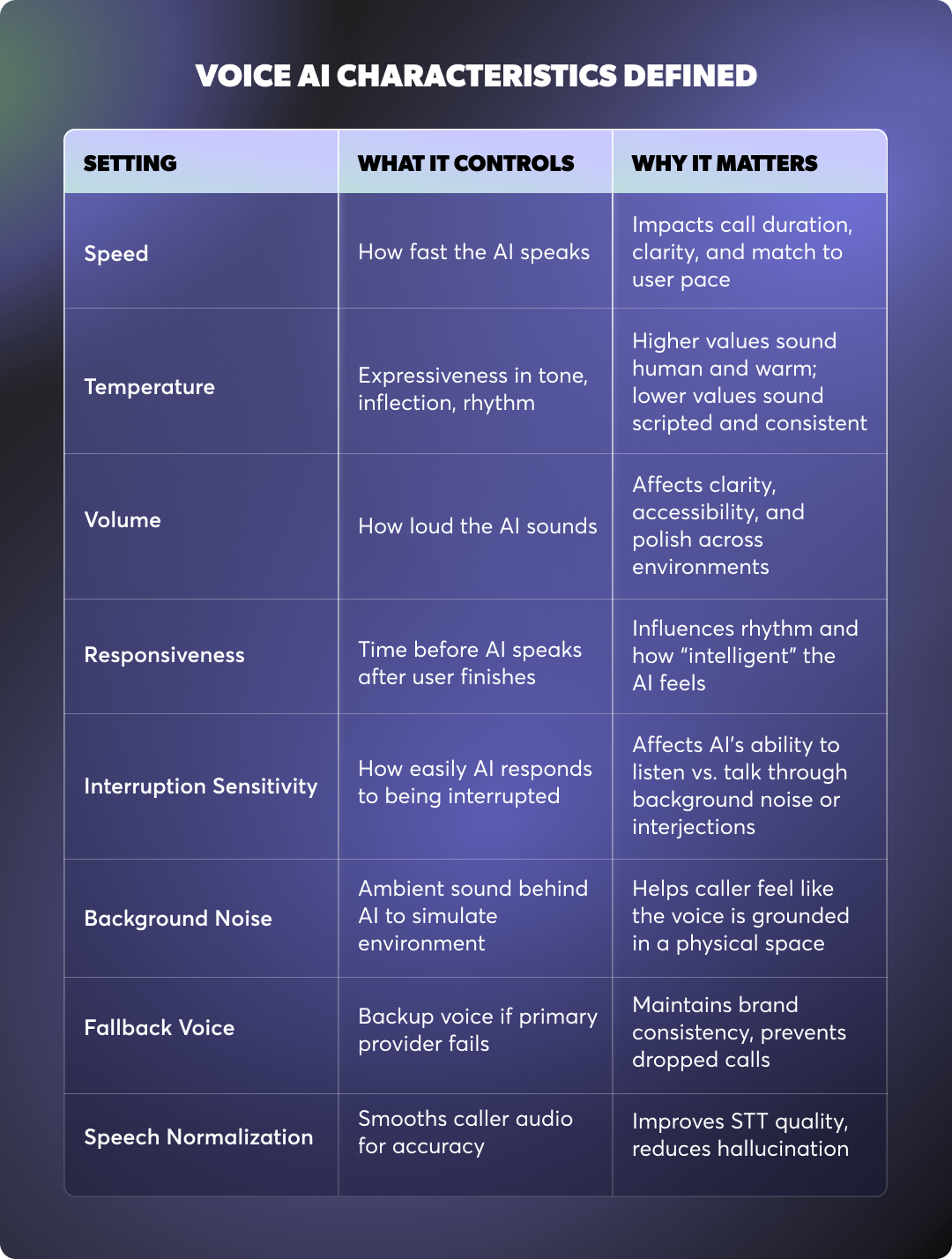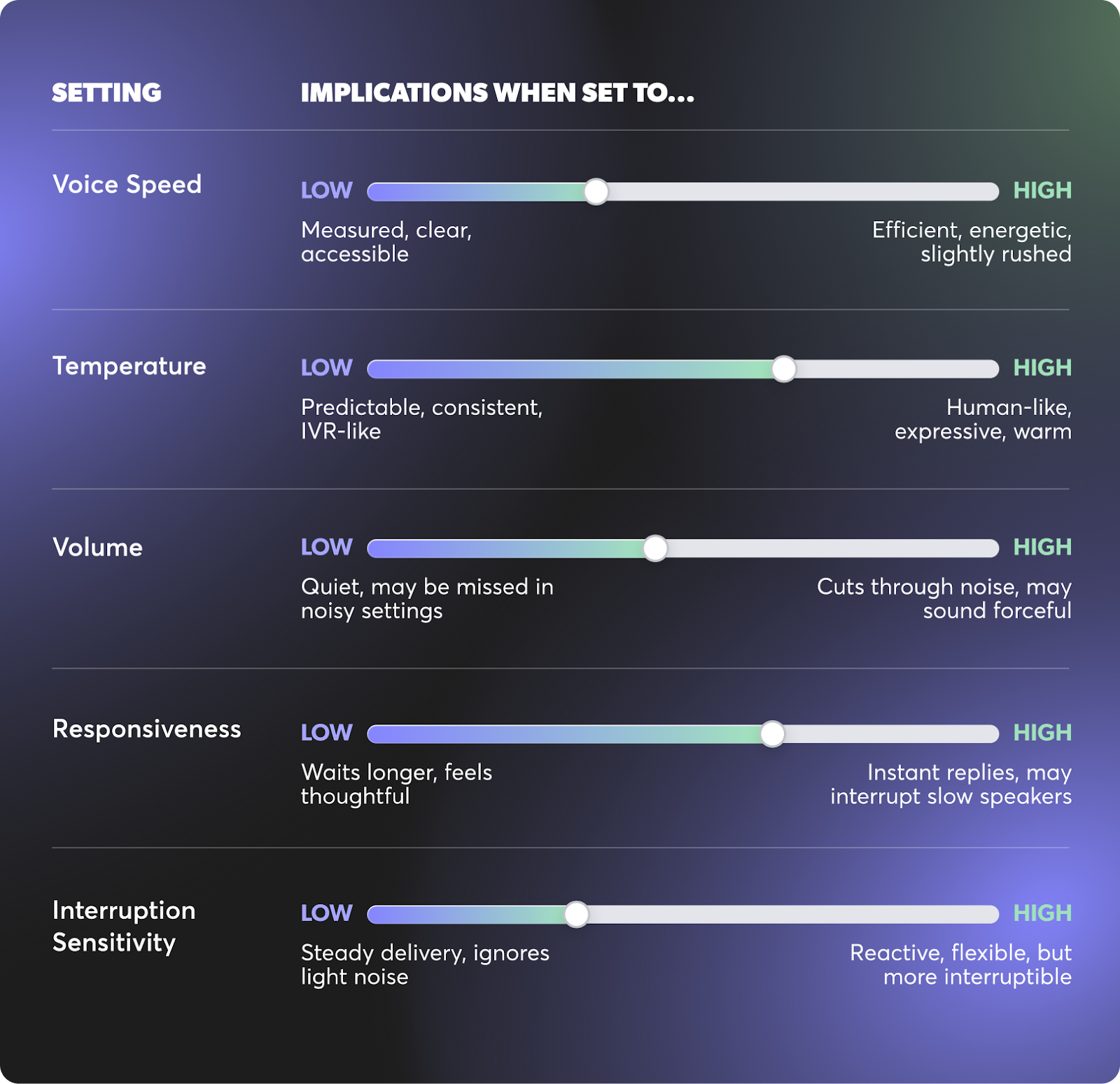
September 2023 Releases
A convincing AI voice isn’t just defined by the words it says.
It’s defined by much more. Pacing, tone, timing, how it converses, interacts, reacts, and how it handles interruptions.
This article outlines the core characteristics that influence how voice AI is perceived on live calls. From mechanical traits like speed and volume, to more emotional and conversational behaviors, we’re going to look at what those characteristics mean, why they matter, and how they impact your bottom line.
We’ll also touch on some of the technical layers behind the voice AI experience (LLMs, voice providers, and real-time data retrieval via RAG), because even the best tone or pacing settings rely on the infrastructure underneath to work consistently in live conversations.
When designing voice agents that need to earn trust and consistently represent your brand, knowing what settings are available and how they work is crucial to driving outcomes.

These are the traits that characterize how the voice sounds mechanically. Tuning these characteristics helps ensure calls are smooth, intelligible, and operationally efficient.
Voice speed determines how fast the AI Agent delivers each word. It affects the rhythm and density of a conversation.
Faster speech means more information in less time, while slower speech can feel more measured and reassuring.
Why it matters:
Voice volume adjusts the loudness of the AI Agent’s audio output. Here, it’s not about emotional intensity, but the technical amplitude of the voice in the audio stream.
Why it matters:
Emotional voice characteristics are those that determine how expressive, warm, and empathetic your AI Agent sounds.
That includes its tone, personality, and how much it varies from one response to the next. These attributes shape how your brand is perceived and how callers feel during interactions.
Voice temperature controls the emotional variability in the agent’s delivery (tone, inflection, and rhythm shift across responses).
A low temperature produces steady, uniform speech. A higher temperature adds variance and emotional range.
Why it matters:
Low Temperature
High Temperature
While temperature primarily controls the voice’s level of expressiveness, you can fine-tune its feel by:
These tools can be layered (along with the characteristics below) to evoke the right emotional tone for different use cases.
It’s worth experimenting with different voice options, because slight shifts can materially change how the agent feels to the customer.
Conversational characteristics influence how the AI Agent manages the flow of dialogue. In other words, when it speaks, how it listens, and how it handles interruptions.
These settings shape how human the interaction feels, especially in dynamic or fast-moving calls.
Responsiveness determines how quickly the AI Agent begins speaking after the caller finishes talking. It affects the natural rhythm and pacing of the conversation.
Why it matters:
Low Responsiveness
High Responsiveness
Interruption sensitivity controls how easily the AI Agent detects and responds when a caller speaks over it. Higher sensitivity allows for quick adjustment. Lower sensitivity requires more deliberate interruption.
Why it matters:
Paired with the other settings, interruption sensitivity can be another determining factor of how friendly or thoughtful (how good of a “listener”) the AI feels to callers (e.g. higher sensitivity with a higher temperature for more laid back conversations, or lower sensitivity with a lower temperature for more stern, professional conversations).
The right level of sensitivity can also help you determine when to drive additional workflow actions. If a caller is continuously interrupting, say more than three times in a call, you can prompt the AI to get the conversation back on track, or take an escalation step.
Low Interruption Sensitivity
High Interruption Sensitivity
These voice settings affect how polished, adaptable, and resilient the voice experience feels across different environments and scenarios. They’re particularly important for system stability.
Background noise adds subtle ambient sound (like a call center, cafe, etc.) behind the AI Agent’s voice during calls. This doesn’t affect what the agent hears, but instead makes the voice sound like it exists in a real physical space.
Why it matters:
Speech normalization smooths out variations in a caller’s voice, adjusting for volume, pitch, or microphone quality, so the AI can better understand and respond.
Why it matters:
Fallback voices refer to the alternate voice (or voices) an AI Agent can use if the primary voice provider becomes unavailable.
Why it matters:

At Regal, we make it easy to fine-tune your AI Agent’s voice so it sounds and behaves the way your brand needs it to. Whether you're aiming for warm and conversational, calm and professional, or energetic and persuasive, our configuration tools let you control tone, pacing, behavior, and more.
You can choose from dozens of high-quality voices across providers, with support for 20+ languages and regional accents to match your customer base.
Every agent includes built-in fallback routing between providers to ensure reliability, even during provider outages.
Voice characteristics like speed, temperature, volume, and interruption sensitivity are fully adjustable per agent or campaign, so you can tailor delivery to each use case. And with real-time knowledge integrations, your agent will sound informed and aware on every call, no matter the contact.
With Regal, you can test, tune, and customize every element of your AI Agent’s voice to align with your brand, audience, and operational goals. You can even clone voices or run A/B tests to see what works best across segments.
Curious how it sounds live? Try it out here.
Book a demo to leverage AI agents for your specific needs. and hear how Regal brings your AI voice to life.

Ready to see Regal in action?
Book a personalized demo.









